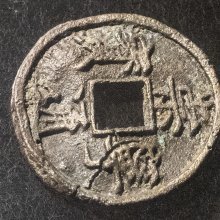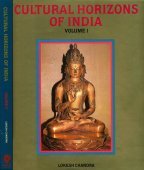Abhayagiri, Abhaya-giri: 7 definitions
Introduction:
Abhayagiri means something in Buddhism, Pali, Hinduism, Sanskrit, the history of ancient India. If you want to know the exact meaning, history, etymology or English translation of this term then check out the descriptions on this page. Add your comment or reference to a book if you want to contribute to this summary article.
Images (photo gallery)
In Buddhism
Theravada (major branch of Buddhism)
Source: Pali Kanon: Pali Proper NamesA celebrated monastic establishment on the north side of Anuradhapura, consisting of a vihara and a mighty thupa. Only the thupa now stands. It was built by King Vattagamani Abhaya on the site of the ancient Tittharama, 217 years, 10 months and 10 days after the founding of the Mahavihara (Mhv.xxxvii.78-83). Tradition states that when the king was fleeing from the Tamils he passed the Tittharama on his way, and the Nigantha Giri, who then lived there, made insulting remarks about him. The king vowed, if he were returned to the throne, to build a vihara on that spot (Mhv.xxxvii.43-4); he fulfilled his vow, and the name of the vihara was a combination of his own name and of that of the Nigantha. The monastery was given in charge of the Thera Mahatissa of Kuppikala and of two other monks, Kuppikala having befriended the king in his misfortunes.
The vihara advanced rapidly in wealth and in power, but quite soon the monks seceded from the Mahavihara fraternity because, according to the Mahavamsa (Mhv.xxxvii.95ff), an incumbent of the Mahavihara, Mahatissa by name, was expelled from the monastery for frequenting lay families. His disciple, Bahalamassutissa, went in anger to Abhayagiri and formed a separate faction.
A Sinhalese chronicle, the Nikaya Sahgraha (pp.11, 12; also P.L.C.42), states that these dissentients were soon after joined by a body of Vajjiputtaka monks from the Pallarama in India, under the leadership of a teacher called Dhammaruci, and the sect which they together founded in Ceylon became known as the Dhammaruci Nikaya, with headquarters in Abhayagiri.
For quite a long while the two fraternities, that of the Mahavihara and that of the Abhayagiri, seem to have lived in amity, alike enjoying the munificence of patrons (Ibid., 52f.; Mhv.xxxv.20, 57, 119-22; xxxvi.7-14). Thus, Gajabahukagamani raised the height of Abhayuttara thupa (as the thupa at Abhayagiri seems to have been called) and made the Gamanitissa tank to be used for the cultivation of land for the maintenance of the vihara (Ibid., xxxv.119-22); Kanitthatissa built a splendid structure in the same vihara for the Thera Mahanaga; it was called the Ratanapasada (xxxvi.7, 8.).
But in the reign of Voharakatissa, the Abhayagiri monks openly adopted the heretical Vaitulya Pitaka (of the Mahayanists see Mhv. trans. 259, n.2). An inquiry was held by the king with the help of his minister Kapila, the heretical books were burnt and the monks of Abhayagiri disgraced (Mhv.xxxvi.40-1).
Soon afterwards, however, the heretics won over the king Mahasena to their side and destroyed the establishment of the Mahavihara, carrying away all the materials to Abhayagiri (P.L.C. 53; Mhv.xxxvii.10-16). Later, Mahasena repented of his ways, burnt the books of the Abhayagiri monks and transferred his patronage to the Mahavihara.
Theravāda is a major branch of Buddhism having the the Pali canon (tipitaka) as their canonical literature, which includes the vinaya-pitaka (monastic rules), the sutta-pitaka (Buddhist sermons) and the abhidhamma-pitaka (philosophy and psychology).
General definition (in Buddhism)
Source: Buddhism Tourism: Glossary of Buddhist TermsAn ancient monastery in Sri Lanka built by king Vattagaman. Unlike the great Monastery, Mahavihara, this monastery was given to an individual monk. The residents of Abhayagiri were referred to as belonging to Dhannaruci School.
Source: eBooks@Adelaide: A Record of Buddhistic KingdomsMeaning “The Fearless Hill.” There is still the Abhayagiri tope, the highest in Ceylon, according to Davids, 250 feet in height. Built about B.C. 90, by Watta Gamini.
The Tripitaka was first reduced to writing, 330 years after the death of Sakyamuni.
India history and geography
Source: archive.org: Ceylon Branch of the Royal Asiatic Society 1963Abhayagiri-vihāra is the name of a temple complex founded in B.C. 89 within the city of Anurādhapura.—Abhayagiri-vihāra (also known as Uttara, Abhayauttara, Abhayaturā, Abāgiri, Abagiri-mahavihara, Apahayagara, Abahay-giri and Bagirivehera) was founded in March, B.C. 89, by king Vaṭṭagāmaṇi Abhaya who demolished a Nigaṇṭha (Jain) shrine called Titthārāma, built by Paṇḍukābhaya in the 4th century B.C., and erected, on its site, a vihāra of 12 cells; Abhayagiri is a combination of the king’s name, Abhaya, with that of the Jain ascetic, Giri, who lived in the Titthārāma.
Source: academia.edu: The school of Abhayagiri (history)Abhayagiri complex:—According to archaeological surveys in Sri Lanka, the Abhayagiri complex spread over 500-600 acres. Historical records and inscriptions tell us that the biggest, the most beautiful and the richest monastery of the Island during the ancient period was the Abhayagiri. Some scholars believe that the ‘Golden Doors’ of Sinhalese Buddhism were opened with the emergence of the Abhayagiri fraternity. The Abhayagiri, which existed over a thousand years, was the first and the most influential Buddhist fraternity separated from the Mahāvihāra.
The literaral meaning of Abhayagiri is ‘fearless mountain’. The Sri Lankan chronicles explained that this name was given by King Vaṭṭagāmiṇī by combining his name and Giri Nighaṇṭha’s.
The Abhayagiri turned out to be the biggest monastery in the Island encircling 500- 600 acres. Pāli commentaries record that Abhayagiri is one of the biggest temples where there were 12,000 monks. According to Fa-Xian, there were 5000 monks at Abhayagiri while 3,000 monks at Mahāvihāra. At the same time Cetiyagiri also belonged to the Abhayagiri and there were 2,000 monks there.
Source: Ancient Buddhist Texts: Geography of Early BuddhismAbhayagiri (अभयगिरि) is the name of a mountain as recorded in the Pāli Buddhist texts (detailing the geography of ancient India as it was known in to Early Buddhism).—Abhayagiri (cf. Dīpavaṃsa and Mahāvaṃsa) is outside the north gate of the ruined city of Anurādhapura, Ceylon.

The history of India traces the identification of countries, villages, towns and other regions of India, as well as mythology, zoology, royal dynasties, rulers, tribes, local festivities and traditions and regional languages. Ancient India enjoyed religious freedom and encourages the path of Dharma, a concept common to Buddhism, Hinduism, and Jainism.
Languages of India and abroad
Sanskrit dictionary
Source: Cologne Digital Sanskrit Dictionaries: Goldstücker Sanskrit-English DictionaryAbhayagiri (अभयगिरि):—Dwandwa. See abhayagirivihāra. E. abhaya (a proper name) and giri (a proper name).
Sanskrit, also spelled संस्कृतम् (saṃskṛtam), is an ancient language of India commonly seen as the grandmother of the Indo-European language family (even English!). Closely allied with Prakrit and Pali, Sanskrit is more exhaustive in both grammar and terms and has the most extensive collection of literature in the world, greatly surpassing its sister-languages Greek and Latin.
See also (Relevant definitions)
Partial matches: Giri, Abhaya.
Starts with: Abhayagiri Vasinah, Abhayagirika, Abhayagirivasin, Abhayagirivihara.
Full-text (+99): Abhayagirivihara, Abhayagirivasin, Virankurarama, Silameghapabbata, Kolavapi, Anganasalaka, Tiputthulla-vihara, Uttarasena, Uttaralha, Kappura-parivena, Kassapa-pasada, Abhayacala, Abhayuttara, Abhaya Vihara, Vajirasena, Mahalekha, Mahadaragiri, Tiputthulla, Sanghasenapabbata, Abhayagiri Vasinah.
Relevant text
Search found 20 books and stories containing Abhayagiri, Abhaya-giri; (plurals include: Abhayagiris, giris). You can also click to the full overview containing English textual excerpts. Below are direct links for the most relevant articles:
Dipavamsa (study) (by Sibani Barman)
Mahavamsa (by Wilhelm Geiger)
Visuddhimagga (the pah of purification) (by Ñāṇamoli Bhikkhu)
Background and Main Facts < [Introduction]
The Vimuttimagga < [Introduction]
B. The Taste of the Noble Fruit < [Chapter XXIII - The Benefits in Developing Understanding]
There’s No Place Like Here (by Ajahn Sumedho)
A Record of Buddhistic Kingdoms (by Fa-Hien)
Amaravati Art in the Context of Andhra Archaeology (by Sreyashi Ray chowdhuri)
Artistic Connectivity between Amarāvatī and Sri Lanka < [Chapter 5 - Impact of Amarāvatī Art]
Related products




